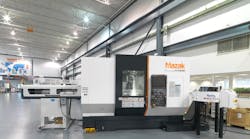Mazak plans to highlight the advantages for productivity and unattended operation with its new Hyper Quadrex 250 MSY turning center at IMTS 2012. For the first time, Mazak explained, the machine will be equipped with a bar feeder that uses the MTConnect open communications protocol. The machine builder claimed its multi-tasking system that’s well suited for automotive industry production, capable of faster cycle times and better efficiencies than other comparable machines thanks to its advanced twin-spindle, twin-turret construction.
The twin-spindle and twin-turret configuration of the Hyper Quadrex 250 MSY gives automotive manufacturers unequaled part-processing opportunities, including enhanced “done-in-one” capabilities where it can complete machining from slug material in a single set-up. Also, the balances cutting of the upper and lower turrets promotes high part throughput and ensures a wide range of workpieces.
The twin opposed turning spindles can operate together or separately, allowing a single part to be machined on all surfaces through a coordinated “hand-off” between spindles, or two different parts can be machined simultaneously on one machine. The spindles are supported by large diameter bearings for high spindle rigidity. The main spindle features a 10-in. chuck, 3.58-in. spindle bore, and 35-hp integral spindle motor that provides a maximum 4,000-rpm speed, while the second spindle has an 8-in. chuck, 2.55-in. spindle bore, and a 30-hp integral spindle motor that offers a 5,000-rpm top speed. Both have full C-axis CNC control for part positioning and contouring with indexing increments of 0.0001 degrees.
Because the twin turrets operate independently or together on the same workpiece, the Hyper Quadrex 250 MSY can machine two different features on a workpiece simultaneously, or follow a balanced machining strategy where two tools work together on the same workpiece feature. Where the part configuration permits, balanced machining can remove up to 25 percent of the cycle time.
The Hyper Quadrex 250 MSY features the new Mazatrol Matrix 2 CNC control. Within the control are enhanced hardware and software functionalities that make the control easy to use while delivering high accuracy and increased productivity. Control hardware performance is much faster, with higher processing speeds for small increment operation that provides shorter cycle times as well as superior surface finishes.
For continuous unmanned operations, the Hyper Quadrex 250 MSY integrates easily with an optional bar feeder and robot loader.
At IMTS, Mazak will demonstrate the machine with a bar feeder and, for the first time, attendees will see MTConnect work in conjunction with the bar feeder. MTConnect is an open communications protocol that provides “interconnectability” in manufacturing. This free and open protocol allows devices and systems from different suppliers to capture and share information in a common format. All Mazak CNC controls are MTConnect compliant and, together, allow Mazak customers to simplify the monitoring and management of their production systems as well as improve machine tool utilization and throughput.
As part of Mazak’s Five Levels of Multi-Tasking, the Hyper Quadrex 250 MSY is a Level 2 machine – those with Y-axis off-center machining. Mazak’s Five Levels of Multi-Tasking allow manufacturers to match machine capabilities precisely to part processing requirements. Machine features and functionalities in the other four levels include from single-spindle and rotating tool capabilities (Level 1) to machines featuring independent milling spindle headstocks with B-axis indexing (Level 3), as well as full Y-axis travels and tool storage, and machines with full simultaneous 5-axis capability (Level 4) as well as “ultra-tasking machines” (Level 5) with additional specialized machining functions and multi-tasking automation.






